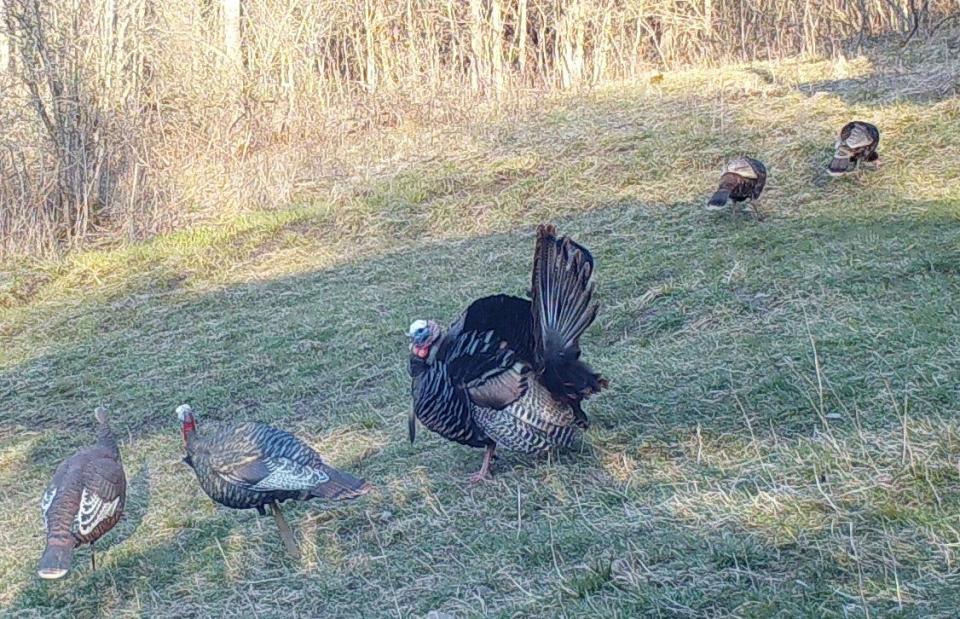In the age of ground blinds and decoys, old turkey hunting techniques still have benefits
Looking back over the decades of spring gobbler hunting, some of the old early truisms still stand the test of time, but others ... not so much.
Hard to believe that it was 40 years ago this year we videotaped our first gobbler kill.
Back then, some of you old timers might remember camcorders. They were little movie cameras with cassettes.
Our phones, so ubiquitous now, show how far technology has advanced, smaller … much smaller, and so much more user friendly.
The old camera recording device we used was called a "three-tube video camera" ... powered then by the now obsolete cathode ray tubes, and it weighed a ton!
I carried it on my shoulder, like a stubby bazooka, up the ridges and down the hollows after gobblers.
The behemoth camera was white plastic and wrapped back and forth with an entire roll of camo-tape so we could clandestinely "shoot" in the woods.
The cables off the back of the camera fed into a heavy box, slung over my shoulder into a converted camo-ammo bag that contained the VCR recorder and cassette. Around my waist was a battery pack belt. We had a smaller camera, but the resolution of the second generation tapes (remember this was pre-digital) were just too grainy, so we bit the bullet and invested in the big camera.
Hunting for spring toms was beginning to really catch on by the early 1980s. But we had learned how to call gobblers in the 1970s, and there, made our bones in the turkey woods.

One of the basic tenets of turkey hunting has become in some ways marginalized by new hunting technology.
Modern camo popup hunting blinds have taken away one of Mr. Tom's most perceptive senses ... his incredible eyesight.
Many turkey hunters, when on the move, do not pay enough deference to the uncanny ability of a gobbler to pick out a hunter moving through the woods, especially in the early season in years with a late spring and few leaves on the trees or understory.
Our old saying went, "If an acorn falls from a tree 100 yards away, a deer hears it, a bear smells it, and a turkey sees it."
Hunting blind setups with decoys were virtually unheard of back in the 1970s and 1980s, even into the 1990s!
Camouflage clothing was all important and many of us rotated our clothing patterns to mirror the changes in the foliage we hunted, favoring browns and grays in the early season, and trending towards green patterns in the late going as Memorial Day and the end of the season approached, here in the north.
Of course when we hunted the southern states, foliage exploded. And when it was greening up in West Virginia, with the redbuds in full bloom, here in Western NY, it can still be leafless.
Mobility was all-important back in the old days, and we chased gobbles from one ridge to another. We wore the treads off our boot soles.
Nowadays, many successful hunters utilize ground blinds and sit with a spread of decoys in a food plot, or staging area. The whole setup can be packed on an ATV, replete with its own camo-cover. And when the hunter is not watching the field, can be entertained with a smart phone, passing the time in cyberspace on social media, as many hunting setups are within cellular reception range.

Personally, I prefer the old-fashioned "run-and-gun" style of turkey hunting to the sedentary style so often portrayed now on the hunting TV shows and videos.
Foregoing the blind style of turkey hunting is good for the mind and body, great exercise.
So much of turkey hunting in the spring of the year has always been to wander around the woods and check out different aspects of the unfolding springtime.
Sitting in a camo tent, though admittedly successful, is a little too mentally restrictive for my old brain and senses.
More: Whitetails are moving into our yards. Could a change in state policy help keep them away?
When I am turkey hunting in the spring, sometimes I fill my game pouch with leeks, pick a cluster of morels, maybe find a shed antler, or explore a new deer trail off the beaten path.
Over the years I've had more than one hunting buddy question my seriousness to the sport and dedication to calling in a bird for him, when I begin pawing through a unique rock outcropping, spend time analyzing a Pileated woodpecker-sculpted tree, or pick mayflies out of a spider web over a trout stream.
And after a long, cold winter of virtual physical lethargy, I always shed pounds by the time Memorial Day rolls around and that's, ahem ... you could call it another "side benefit" of spring turkey hunting the old way.
-- Oak Duke writes a weekly column.
This article originally appeared on The Evening Tribune: Old turkey hunting techniques offer advantages over today's technology

